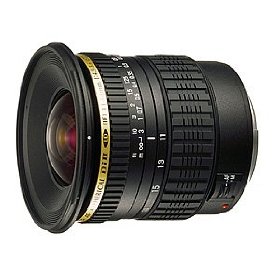
Photo Zone
The Tamron AF 11-18mm f/4.5-5.6 Di II SP is surely capable to deliver decent quality images but the truth is that the competition is generally better in most aspects. Regarding the comparatively slow speed (max. aperture), the subjectively lower build quality as well as the rather limited zoom range it is also a bit strange that Tamron is asking a higher price point compared to the Sigma and Tokina counterparts (locally at least). This doesn’t seem to leave many arguments in favour of the lens.READ FULL REVIEW
Other Tamron 11-18mm f/4.5-5.6 Di II SP AF Reviews
Luminous Landscape
In early June, 2005 the Tamron 11-18mm lens became available. This lens, in mounts for Nikon, Minolta and Canon, is Tamron’s first ultra-wide lens designed specifically for reduced frame (APS-C sized) sensors. In fact, while it will fit on a full frame film or DSLR, the image circle is insufficient to cover the full field. But, unlike Canon’s EFS lenses, such as its 10-22mm f/3.5-4.5, which are limited to S mount bodies such as the Rebel/XT and 20D, the Tamron will fit earlier reduced frame digital bodies such as the 10D, D60 and D30. If you put the lens on a film camera, or a full frame digital camera such as the Canon 1Ds MKII, you will not get a usable image outside of the APS-C sized format area. If you’re looking for an ultra-wide zoom for your 1.5x or 1.6x lens factor DSLR then I can recommend the Tamron SP 11-18 f/4.5-5.6 Di II LD to you. The price is attractive and the lens is capable of producing high quality images.
SLR Gear
The smaller frame size helps make the lens compact, and also helps quite a bit with the optical tradeoffs involved in lens design. Our test sample seemed to consistently produce details on the left side of the frame at its 11mm setting, but at other focal lengths performed very well indeed. (And the softness on the left side at 11mm rapidly gets better as you look toward the center of the frame.) At 11-15mm, best overall sharpness occurs between f/8 and f/11, while at 18mm, the best sharpness is found at f/8. Particularly when stopped down, center sharpness is excellent across the board, but the extreme left corners are always a little soft at the widest 11mm setting. This lens looks like a good choice for an affordable ultra-wide zoom. It doesn’t quite measure up optically to the Canon 10-22mm or the Nikon 12-24mm, but is considerably cheaper than either of those models, a real help if you’re working with a limited budget. If you’ve been hankering to try some real wide angle shooting with your digital SLR, the Tamron 11-18mm f/4.5-5.6 Di II deserves a look.READ FULL REVIEW
Photo Review
Tamron’s new SP AF11-18mm F/4.5-5.6 Di-II LD Aspherical (IF) lens is the company’s first ultra-wide zoom lens designed exclusively for DSLR cameras with ‘APS-C size’ sensors. Available with Canon, Konica Minolta and Nikon mounts, it is surprisingly compact. This is largely due to a new design that uses a large-aperture glass-moulded aspherical element, hybrid aspherical elements and elements made from high index/high dispersion glass and low dispersion optical glass. You pay a premium for these high-tech materials but the overall performance of this lens fully justifies its price and it remains more affordable than similar lenses from the camera manufacturers.READ FULL REVIEW